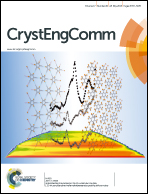Mechanism of hydrogen treatment in KTiOPO4 crystals at high temperature: experimental and first-principles studies†
Abstract
Hydrogen annealing experiments on KTiOPO4 (KTP) crystals with different temperatures, times and hydrogen concentrations were conducted in an atmospheric furnace. Theoretically, in order to analyze the reaction mechanisms of KTP under high temperature hydrogen annealing, the electronic structure, density of states and optical properties of stoichiometric KTP and KTP with different concentrations of oxygen vacancies and of OH were calculated from first-principles. In addition, various analytical methods were also used to study the mechanism of high temperature hydrogen annealing of KTP. The results show that oxygen ions diffuse from the interior to the surface under conditions of high temperature and hypoxia. Since the high temperature provides enough energy for the chemical reaction, a number of oxygen ions react with H2 to produce H2O, and a small portion is released in the form of O2. As a result, oxygen vacancies are generated in the crystals, and a number of Ti4+ ions transform to Ti3+ for charge compensation. A correlation is established between the color (absorption intensity) of KTP after hydrogen annealing and the number of oxygen atoms removed. This work is helpful to better understand the formation mechanism of gray tracks in KTP.


 Please wait while we load your content...
Please wait while we load your content...